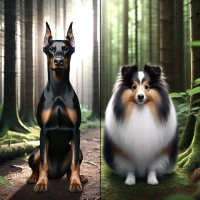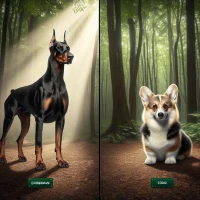The Doberidgeback: A Unique Blend of Strength and Energy
The sun was just peeking over the horizon when I first laid eyes on Max, a Doberidgeback. My friend Lisa had just adopted him, and I was curious about this intriguing mix known as a Doberidgeback—a cross between the majestic Doberman Pinscher and the sturdy Rhodesian Ridgeback. 🌞 Seeing Max prance around Lisa’s backyard got me thinking about the unique features and qualities this hybrid dog possesses.
A Tale of Two Breeds
Before diving into the specifics of the Doberidgeback, let’s look at the two breeds it comes from. The Doberman Pinscher, for instance, was developed in Germany during the late 19th century and is known for its loyalty, intelligence, and fearless nature. The Rhodesian Ridgeback, originating from Southern Africa, was initially bred to hunt lions and possesses great endurance and agility.
You’d think combining two such intense breeds might be a recipe for chaos, but it’s anything but! This hybrid makes for a fascinating companion that balances vigor with a calm, strong-willed temperament.
Physical Appearance: A Striking Combination
When it comes to looks, the Doberidgeback gets the best of both worlds. Typically, these dogs sport the muscular build and sleek lines of a Doberman with the distinct ridge of fur running down their back—a signature trait of the Ridgeback.
Max, for instance, had this sleek, shiny coat that just gleamed in the sunlight. He had a robust frame but moved with the grace and elegance of an athlete. His coat was a deep mahogany, almost like fine teakwood. It’s no wonder folks often stop Lisa, asking about him.
Temperament: Loyal, Protective, and Energetic
I remember dog-sitting Max for a weekend. Holy moly, that dog has energy for days! We jogged, played fetch, and I swear he still wanted more. Doberidgebacks are known for
their boundless energy and require lots of physical exercise. This makes them ideal companions for active individuals or families.
They’re also fiercely protective. Lisa once told me that Max could sense her anxiety and would immediately stay close, as if to reassure her. But, despite their protective instincts, they’re generally friendly and social dogs.
Training Tips: Early Socialization and Consistency is Key
When it comes to training, Doberidgebacks benefit greatly from early socialization and consistent routines. They’re highly intelligent and pick up commands quickly, but they can also be a bit headstrong. Max had his difficult days; sometimes he’d just stubbornly refuse to sit still during training sessions. But with patience and a lot of treats, he’s now quite the obedient pooch.
Health Concerns: Things to Watch Out For
Every breed has its health quirks, and the Doberidgeback is no exception. Common issues might include hip dysplasia and a predisposition to certain heart conditions. Routine vet check-ups are essential. The other day, I read a fascinating fact: both Dobermans and Ridgebacks are relatively susceptible to hypothyroidism. This means it’s crucial to monitor their diet and exercise regime closely.
And oh boy, do they love food! Max once chewed through a bag of dog treats I accidentally left on the kitchen counter. Safe to say, he got a stern talking-to that day!
Nutritional Needs: Fueling the Beast
Doberidgebacks require a balanced diet rich in proteins to support their active lifestyle. High-quality dog food, with meat as the first ingredient, is ideal. Lisa swears by a mix of homemade meals and commercial brands that cater to large, active breeds. A little fun fact: Doberidgebacks can sometimes be finicky eaters. Max had phases where he’d only eat if his food was mixed with a bit of chicken broth. Spoiled? Maybe just a bit.
Exercise: The Key to Happiness
It’s often said, “A tired dog is a happy dog,” and nowhere does this apply more than with the Doberidgeback. These dogs thrive on physical activity, and regular exercise helps channel their energy positively. This might be through running, long walks, or even agility training.
One weekend, Lisa and I took Max on a hiking trail nearby. I’ll never forget the sight of him racing up the hill, then pausing to turn and look at us, as if saying, “Come on, slowpokes!” He truly embodies the spirit of both his parent breeds.
Grooming: Maintaining that Glossy Coat
Despite their short coats, Doberidgebacks do shed and benefit from regular brushing. They’re relatively low-maintenance, grooming-wise, compared to some other breeds. But they do love a good bath; Max revels in bath time, playing with water and splashing everywhere. It’s a messy affair but oh so adorable!
Living Conditions: Adapting to the Environment
While Doberidgebacks can adapt to various living conditions, they thrive in homes where they have space to roam. Apartment living might work, but only if given ample opportunity to exercise. Lisa lives in a suburban house with a big backyard, which is perfect for Max.
Still, they’re quite adaptable. With the right amount of mental and physical stimulation, they can thrive almost anywhere. Just make sure they’re not cooped up too long, or you might find your furniture—or worse—chewed up.
Social Behavior: Integrating with Family and Other Pets
Doberidgebacks are generally good with families and do well with other pets if properly socialized from a young age. However, their protective nature means they might be wary of strangers initially. Max, for instance, warms up to people quickly but always keeps one eye on Lisa. It’s this blend of friendliness and alertness that makes them such good family dogs.
My Personal Experience with a Doberidgeback
One autumn evening, while sipping on hot cocoa, Lisa and I were talking about how Max changed her life. She mentioned how secure she felt with him around, especially during early morning runs. His loyal nature gave her a sense of safety and companionship that’s hard to find.
From my perspective, having spent those weekends with Max, I can say that owning a Doberidgeback is not for the faint-hearted. They’re demanding in terms of time, exercise, and training, but the rewards are immense. Picture the wagging tail greeting you at the door, the eager eyes waiting for your next command, and the undying loyalty that these dogs offer.
Community and Support
Interestingly, there’s quite a warm and welcoming community around Doberidgeback owners. Online forums, social media groups, and local meet-ups provide a wealth of information and support. It’s reassuring to know that others share your challenges and joys. Lisa found a local group where she met other hybrid dog owners, exchanging tips and organizing playdates. Having that sense of community really helped her in navigating the nuances of training and raising Max.
Common Misconceptions: Debunking the Myths
A lot of people think that Doberidgebacks might be too aggressive or hard to manage because of their breed mix. But that’s far from the truth. While they are protective and energetic, with the right training and environment, they’re incredibly loving and well-behaved. They’re not just guard dogs but loyal companions who thrive on human interaction and love.
I find it fascinating how these hybrids can break stereotypes. Sure, they’ve got that intense look, but beneath that exterior is a heart of gold—loving, caring, and fiercely loyal.
Fun Facts About Doberidgebacks
Did you know that both parent breeds have an interesting history? For instance, Dobermans were initially bred by a tax collector named Karl Friedrich Louis Dobermann to protect him during his rounds! 🤯 And Ridgebacks were used to protect livestock from lions in Africa. How cool is that?!
Doberidgebacks in Popular Culture
While not as famous as some purebreds, Doberidgebacks are making their mark. Some movie directors have started favoring them for roles requiring both strength and elegance. They’re visually impressive dogs with a strong presence on screen.
Final Reflections
Overall, raising and owning a Doberidgeback can be an incredibly rewarding experience but it’s not without its challenges. Their high energy levels and strong-willed nature require an experienced owner who can provide lots of exercise and consistent training. Yet, the loyalty and companionship they offer are second to none. They’re more than just dogs; they’re family members, guardians, and friends.
Thanks so much for reading! If you’ve got a Doberidgeback or are thinking of getting one, drop a comment below. We’d love to hear your stories! 🐾
May your days be as full of joy as a Doberidgeback chasing a ball!










